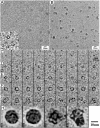Hierarchical self-assembly of amelogenin and the regulation of biomineralization at the nanoscale
- PMID: 21825148
- PMCID: PMC3161614
- DOI: 10.1073/pnas.1106228108
Hierarchical self-assembly of amelogenin and the regulation of biomineralization at the nanoscale
Abstract
Enamel is a highly organized hierarchical nanocomposite, which consists of parallel arrays of elongated apatitic crystallites forming an intricate three-dimensional microstructure. Amelogenin, the major extracellular matrix protein of dental enamel, regulates the formation of these crystalline arrays via cooperative interactions with forming mineral phase. Using cryoelectron microscopy, we demonstrate that amelogenin undergoes stepwise hierarchical self-assembly. Furthermore, our results indicate that interactions between amelogenin hydrophilic C-terminal telopeptides are essential for oligomer formation and for subsequent steps of hierarchical self-assembly. We further show that amelogenin assemblies stabilize mineral prenucleation clusters and guide their arrangement into linear chains that organize as parallel arrays. The prenucleation clusters subsequently fuse together to form needle-shaped mineral particles, leading to the formation of bundles of crystallites, the hallmark structural organization of the forming enamel at the nanoscale. These findings provide unique insight into the regulation of biological mineralization by specialized macromolecules and an inspiration for bottom-up strategies for the materials design.
Conflict of interest statement
The authors declare no conflict of interest.
Figures




Similar articles
-
CryoTEM study of effects of phosphorylation on the hierarchical assembly of porcine amelogenin and its regulation of mineralization in vitro.J Struct Biol. 2013 Aug;183(2):250-7. doi: 10.1016/j.jsb.2013.05.011. Epub 2013 May 23. J Struct Biol. 2013. PMID: 23707542 Free PMC article.
-
Potential role of the amelogenin N-terminus in the regulation of calcium phosphate formation in vitro.Cells Tissues Organs. 2011;194(2-4):188-93. doi: 10.1159/000324827. Epub 2011 May 13. Cells Tissues Organs. 2011. PMID: 21576914 Free PMC article.
-
Amelogenin-collagen interactions regulate calcium phosphate mineralization in vitro.J Biol Chem. 2010 Jun 18;285(25):19277-87. doi: 10.1074/jbc.M109.079939. Epub 2010 Apr 19. J Biol Chem. 2010. PMID: 20404336 Free PMC article.
-
Amelogenin supra-molecular assembly in vitro compared with the architecture of the forming enamel matrix.Cells Tissues Organs. 2005;181(3-4):202-18. doi: 10.1159/000091382. Cells Tissues Organs. 2005. PMID: 16612086 Review.
-
Amelogenins: assembly, processing and control of crystal morphology.Matrix Biol. 2001 Sep;20(5-6):293-305. doi: 10.1016/s0945-053x(01)00154-8. Matrix Biol. 2001. PMID: 11566263 Review.
Cited by
-
TGF-β1 autocrine signalling and enamel matrix components.Sci Rep. 2016 Sep 16;6:33644. doi: 10.1038/srep33644. Sci Rep. 2016. PMID: 27633089 Free PMC article.
-
Microscopy techniques for investigating the control of organic constituents on biomineralization.MRS Bull. 2015 Jun;40(6):480-489. doi: 10.1557/mrs.2015.98. MRS Bull. 2015. PMID: 27358507 Free PMC article.
-
Advanced materials for enamel remineralization.Front Bioeng Biotechnol. 2022 Sep 13;10:985881. doi: 10.3389/fbioe.2022.985881. eCollection 2022. Front Bioeng Biotechnol. 2022. PMID: 36177189 Free PMC article. Review.
-
M180 amelogenin processed by MMP20 is sufficient for decussating murine enamel.J Dent Res. 2013 Dec;92(12):1118-22. doi: 10.1177/0022034513506444. Epub 2013 Sep 26. J Dent Res. 2013. PMID: 24072097 Free PMC article.
-
Directing polymorph specific calcium carbonate formation with de novo protein templates.Nat Commun. 2023 Dec 14;14(1):8191. doi: 10.1038/s41467-023-43608-1. Nat Commun. 2023. PMID: 38097544 Free PMC article.
References
-
- Beniash E, Simmer JP, Margolis HC. The effect of recombinant mouse amelogenins on the formation and organization of hydroxyapatite crystals in vitro. J Struct Biol. 2005;149:182–190. - PubMed
-
- Margolis HC, Beniash E, Fowler CE. Role of macromolecular assembly of enamel matrix proteins in enamel formation. J Dent Res. 2006;85:775–793. - PubMed
-
- Du C, Falini G, Fermani S, Abbott C, Moradian-Oldak J. Supramolecular assembly of amelogenin nanospheres into birefringent microribbons. Science. 2005;307:1450–1454. - PubMed
-
- Lowenstam HA, Weiner S. On Biomineralization. Oxford: Oxford Univ Press; 1989. pp. 175–176.
Publication types
MeSH terms
Substances
Grants and funding
LinkOut - more resources
Full Text Sources
Molecular Biology Databases

